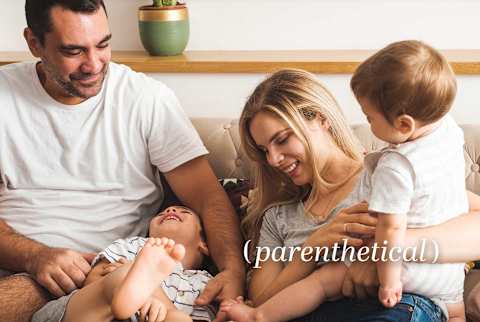Advertisement
A Psychotherapist On What To Do When Partners Have Different Parenting Styles


As a couples therapist and a partnered mother of three children, I witness and have experienced what it feels like when you and your partner might have the same goals—to raise vibrant, mindful, connected children, perhaps—but have very different ideas of how to get there.
So much informs how we define the “right” way to parent: our personal upbringing, our cultural values or belief systems, and our social identities. Disagreeing about parenting interventions is quite common, as research shows that many parents report having different parenting styles.
The best relationships aren’t the ones that have the most in common but rather the ones that negotiate those differences with respect and integrity.
Here are 5 strategies for how to approach difference and disagreement in a way that honors yourself, your relationship, and your children.
Switch the goal
I witness disagreeing parents trying to “convince” their partners to see their side or get on board. The way that human nature works is if one person in the disagreement holds fast to one position, the other person often takes the opposite position (regardless of what they believe) as a reactive response.
Change the goal from “getting on the same page” to communicating about the different pages you and your partner are on. This will create less opportunity for conflict and judgment and more room for curiosity.
Remind yourself that you don’t need to agree to have a content and well-cared-for family but that you and your partner must be willing to come to a mutual understanding in order to reach your parenting goals.
Get to the story under the opinion
Take the emphasis off the content of the fight or choose the parenting intervention and refocus it on how that position came to be. Each of our beliefs, though they feel innate, formed because of something we witnessed, experienced or learned.
Set up time (not when you’re in the heat of the argument) to get to know more about why your partner wants to parent the way they do, and share your “why” as well.
Some questions to consider are:
- Tell me why you think your style is the way we should go?
- How were you parented?
- What do you want to replicate/what do you want to do differently?
- What are you worried about if we approach this situation the way I want to?
- Is one of our parenting styles more suited for one of our children but less for the other?
- What is one thing you refuse to do differently and what is one thing you’re willing to do differently?
- You may even take it a step further and ask yourself: “What if I allow myself to contemplate that my intervention is NOT best for my kids? What if there is another way to get to my goal?”
Get clarity on your top 3
By "top 3" I mean the 3 most important things you want your kid to leave your house knowing or being after 18 years under your guidance.
There are so many different lessons we can teach our kids, but there are only a few that might be essential to how we want to raise them.
With your partner, come up with a list of 3-4 of the most important things you want your kids to have learned from you. And then, create a map, highlighting the way you and your partner can uniquely contribute to making this happen.
For example, “We want our child to be a respectful person, and the way we believe this can happen is by emphasizing kindness toward each other (parent 1’s contribution) and removing him from the room to explain why throwing a ball is unacceptable (parent 2’s contribution)."
Engaging in this activity will not only support you in having a more collaborative discussion by emphasizing the goals you do share but is also strengths-based, highlighting each of your contributions as meaningful and important.
Be mindful to not undermine the other parent in front of your children
If your co-parent does or says something you don’t like (unless it threatens safety), it is more harmful to intervene in front of the children as it portrays division in the parenting department and may set up a “good cop/bad cop” dynamic.
Wait until you don’t feel activated to share how it made you feel or what you did not like, instead of criticizing or judging.
Judgment makes people defensive, as they feel the need to protect themselves, so the more you can focus on your feelings, using “I” statements, without undermining your partner’s, the more likely you’ll be able to find common ground.
After you and your partner have discussed what happened and how you want to move forward, it can be helpful to revisit and address what transpired with your child, to ensure that any ruptures get repaired and your children bear witness to two adults moving through a sticky situation with intention and care.
Opt for consistency in the interventions you choose
Research shows that regardless of what parenting style you and your partner choose from, the key is consistency. Children respond positively when they know what is coming next.
For example, “if I yell at the dinner table, each time I do that my parents take me to my room and sit there with me” or “each time I do this, my parents engage in a discussion about why this is unacceptable for me at the table.”
Being clear and following through, helps to support children in developing an understanding of themselves and the world around them, and helps parents to feel more systematized and goal-oriented, rather than reactive.
The takeaway
Switching the emphasis on wanting to parent the “same” to respectfully exploring the reasons why each parent holds their position, creates new pathways for collaboration and change. Modeling different approaches can be a positive thing for children to see, as long as it's coupled with curiosity about each approach and respectful discussion, eliciting all members of the family’s feelings.
If coming to mutual understanding and working together in the relationship feels impossible, this may be an indicator that you need support in communicating as a couple, and this is less about parenting and more about your relationship.
Watch Next
Enjoy some of our favorite clips from classes
Enjoy some of our favorite clips from classes
What Is Meditation?
Mindfulness/Spirituality | Light Watkins
Box Breathing
Mindfulness/Spirituality | Gwen Dittmar
What Breathwork Can Address
Mindfulness/Spirituality | Gwen Dittmar
The 8 Limbs of Yoga - What is Asana?
Yoga | Caley Alyssa
Two Standing Postures to Open Up Tight Hips
Yoga | Caley Alyssa
How Plants Can Optimize Athletic Performance
Nutrition | Rich Roll
What to Eat Before a Workout
Nutrition | Rich Roll
How Ayurveda Helps Us Navigate Modern Life
Nutrition | Sahara Rose
Messages About Love & Relationships
Love & Relationships | Esther Perel
Love Languages
Love & Relationships | Esther Perel
What Is Meditation?
Box Breathing
What Breathwork Can Address
The 8 Limbs of Yoga - What is Asana?
Two Standing Postures to Open Up Tight Hips
How Plants Can Optimize Athletic Performance
What to Eat Before a Workout
How Ayurveda Helps Us Navigate Modern Life
Messages About Love & Relationships
Love Languages
Advertisement

Do You & Your Partner Have A Spiritual Connection? How To Tell, From A Therapist
Rachel Glik, Ed.D., LPC

Do You & Your Partner Have A Spiritual Connection? How To Tell, From A Therapist
Rachel Glik, Ed.D., LPC









